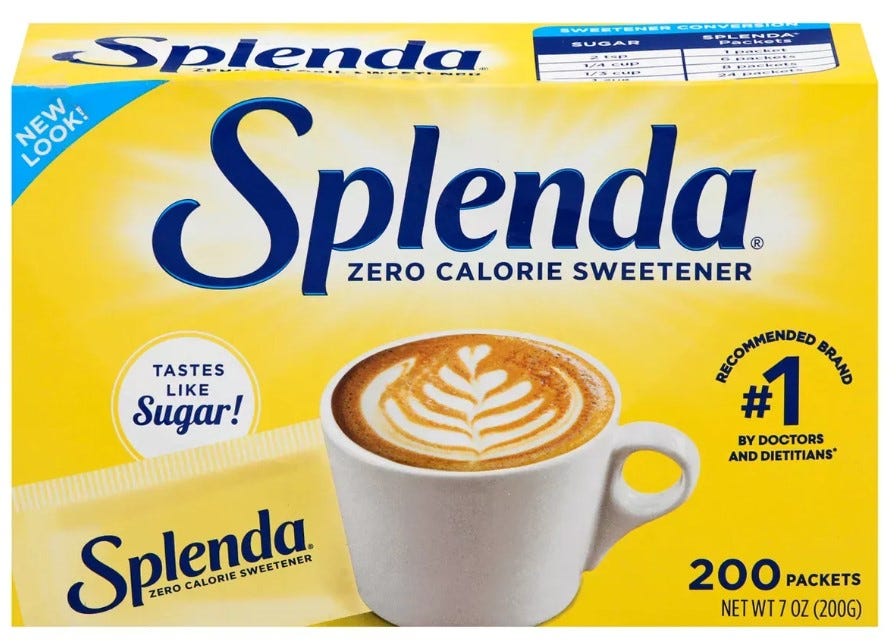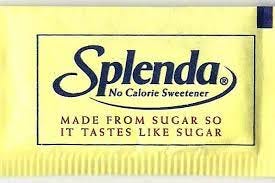What to Know About Splenda
Ignore what the label says: It's neither Zero-Calorie nor Sugar-Free.
Hi. My name is Lynn, and I’m a Splendaholic. Three times a morning, I dose a cup of coffee with a packet of the stuff, which makes it taste as sweet as if I’d added two teaspoons of white sugar. Later in the day, I might be caught dropping a whopping 15 packets into a 3-quart pitcher of Kool-Aid. Fifteen packets is equivalent to 30 teaspoons of sugar, or just over a half cup.
Dear Kool-Aid Police: I know the official recipe calls for a cup of sugar and two quarts of water, but I like my Kool-Aid weak. It tastes better, it’s cheaper, and it’s less bad for me.
The super-sweet artificial ingredient in Splenda, the famous sucralose, is an impressive but somewhat unwieldy 600 times sweeter than sugar. By comparison, aspartame (Equal) is 200 times as sweet, and saccharine (Sweet’N Low) is 400 times as sweet.
They Were Looking for a New Insecticide
Sucralose — the molecule’s proper name is 1,6-Dichloro-1,6-dideoxy-β-D-fructofuranosyl-4-chloro-4-deoxy-α-D-galactopyranoside — was invented by a group of no fewer than five scientists at London’s Tate & Lyle labs way back in 1976. They were looking for a new insecticide when, as legend has it, an eager young scientist was asked to “test” the new molecule but heard “taste” instead of “test” and serendipitously discovered the molecule’s intense sweetness.
(Amazingly, three other artificial sweeteners — saccharine, cyclamate, and aspartame — also were discovered accidentally by absentminded chemists who licked their fingers before washing their hands.)
Alas, because the U.S. Food and Drug Administration (FDA) wanted to make sure Splenda was safe before allowing it to be fed to an unsuspecting public — an effort that included testing the dangers of habitual long-term use over several years — Splenda didn’t appear in U.S. grocery stores until 1999, more than two decades after the accidental taste test. By then, it had won acceptance in Canada, Australia and New Zealand. It became more and more popular after the turn of the century and today is legal in at least 80 countries. The European Food Safety Authority (EFSA) declared it safe in 2004.
Tate & Lyle’s patent on sucralose expired in 2015, so other companies can now produce it generically. (See Happy Belly from Amazon.) China makes the most sucralose. India makes a lot, too. The U.S. makes a little, in Alabama, mostly for Tate & Lyle’s Splenda brand. Since 2015, Splenda has been mixed and packaged by Heartland Food Products Group in Indianapolis, Indiana.
Did you know seven molecules are even sweeter than sucralose?
Lugduname
A mind-boggling 300,000 times sweeter than sugar, it’s not used commercially because of safety concerns.Carrelame
100,000 times sweeter than sugar. Used mainly in research.Sucrononic Acid
20,000 times sweeter. Not used in foods because of safety concerns.20,000 times sweeter. Derived from aspartame, and legal in many countries, including the U.S. and the European Union.
13,000 times sweeter, widely used, related to aspartame.
Thaumatin
3,000 times sweeter, a naturally occurring sweet protein found in the katemfe plant. Popular in Japan.Alitame
2,000 times sweeter. Not popular because it’s difficult to make.
A Tiny Pinch is Plenty
A single packet of Splenda contains about a half teaspoon of white powder. Only the tiniest pinch of that is sucralose, but that’s enough to make it as sweet as two teaspoons of sugar.

If a packet of Splenda contained only the sucralose powder, there’d be so little of it you’d be excused for thinking the packet was empty. The 12 milligrams of ultra-fine sucralose particles — each one about the size of a pollen granule — would be easy to miss.
Perhaps worse, the tiny amount of ultra-fine powder would be difficult to get out of the packet. Some would stick to the inside. Some would drift away on the breeze.
To solve this usability problem, the manufacturers of Splenda carefully mix the fine sucralose powder with two things that have the added benefit of making Splenda look like sugar when you pour it out. These two “bulking agents” account for over 98.8 percent of the 1 gram packet by weight. They make it look like you’re getting something for your money, and also help carry the Splenda dust into your coffee instead of having it blow away in the wind.
Splenda is Mostly Sugar
Half of the aforementioned filler is dextrose, a manufactured sugar with the same chemical structure as glucose, which is what it’s called when found in the bloodstream. Like most carbohydrates, the half gram of dextrose has 2 calories.
The second filler is maltodextrin, a manmade chain of glucose molecules that the body ultimately metabolizes into standalone glucose molecules. There’s a half a gram of maltodextrin in a single packet, too, so it adds another 2 calories.
Incidentally, the same two fillers are used in Equal (aspartame) and Sweet’N Low (saccharine).
The point is that despite using only “zero-calorie“ Splenda in my coffee and Kool-Aid, I’m nonetheless still eating sugar and calories.
My three quarts of Kool-Aid contain about 15 grams of the caloric bulking agents, one gram for each packet. A gram of either filler has about four calories, so there are 60 calories in one pitcher of my “weak” Kool-Aid.
Four calories per packet is more than the zero promised on the label, but it’s close enough for government regulators, who let you call anything “zero calorie” if it has fewer than five calories per serving. Splenda makers have decided a single serving is one packet, and four calories are fewer than five, so Splenda gets to call itself “zero calorie.”
In actual fact, a box of 200 Splenda packets contains a total of 800 calories. (There are real reasons people dislike the government.)
In 2008, Splenda (manufactured at the time by Johnson & Johnson subsidiary McNeil Nutritionals) was forced to stop using the marketing phrase “Made from sugar so it tastes like sugar” after being sued by the company that makes Equal, Merisant. Merisant lawyers argued that Splenda was unfairly trying to make itself sound healthier than Equal, which uses the artificial sweetener aspartame. The case was settled just before the jury announced its verdict. Splenda agreed to drop “made from sugar” but still uses “TASTES LIKE Sugar!”
Paradoxically, the reason Splenda tastes like sugar is that its chemical structure is so close to sucrose (see below) that it reacts with the sweetness receptors on the tongue the way sugar does, only 600 times more energetically. It is, after all, chemically modified sucrose, so “made from sugar” was literally true but still deemed misleading, because chemically modified sucrose does not exist in nature and behaves very differently from sucrose, as anyone who has tried to caramelize a sprinkling of Splenda atop crème brûlée knows.
How It’s Made
As previously mentioned, sucralose is chemically modified table sugar, also known as sucrose. The Tate & Lyle chemists altered the sucrose molecule so that it was not only super sweet but also so chemically sturdy it’s difficult (but maybe not entirely impossible) for the body to metabolize it. That’s what makes sucralose calorie free.
In the diagram below, you can see several places where the “hydroxyl groups” — OH (Oxygen and Hydrogen) — in the sucrose on the left have been replaced by Cl (Chlorine) atoms in the sucralose to the right. Look for Cl in the right image to find the changes. There are three of them.
The three replacement chlorine atoms not only make the molecule difficult to digest, they also make it bind more firmly to the sweetness receptors on the tongue, making it taste super sweet.
By the way, anyone worried about the use of chlorine in the transformation of sucrose to sucralose will do well to remember that everyday table salt, sodium chloride (NaCl), is a marriage of sodium and chlorine. Pure sodium dropped in water explodes. Chlorine gas will kill you so effectively it’s been used in war. *

The Splenda Detractors
A lot of doctors don’t like artificial sweeteners any more than they like sugar, Splenda included. One exception is that they do recommend them for people with diabetes because it doesn’t cause blood sugar spikes, which cause an array of health issues.
More often than not, however, experts agree further testing is needed. The science is, as it is so often, inconclusive.
Some say the artificial molecules trigger insulin resistance by tricking your body into thinking a bunch of glucose is on the way but then not sending it. The excess insulin secreted as a result is suspected of making your body less able to utilize insulin, i.e., insulin resistance, which is considered the first step toward diabetes.
Others say artificial sweeteners increase your appetite, especially your craving for sweets, making bacon-maple donuts harder to resist. So instead of making us thinner, artificial sweeteners might actually make us fatter. We think the Diet Coke leaves room for the bacon double cheeseburger. To be fair, other studies that show artificial sweeteners can help you lose weight by helping you reduce calories.
(Splenda has not saved me from being obese. I have a body mass index around 34. The truth hurts.)
Others say the good bacteria in the digestive tract don’t get along well with sucralose, which is thought to reduce their numbers by half. Those bacteria are critical for good health. The studies pointing in this direction, however, have only included mice.
Likewise, the studies that claimed sucralose damaged DNA were performed in petri dishes. Cause for further research, perhaps, but hardly conclusive.
Still more studies suggest sucralose can cause inflammation, which again is the cause of lots of health problems.
Still others are concerned that the sturdy chemical is making it through sewage treatment processes and into the water, where it may accumulate over time and cause unknown problems. Reverse osmosis (RO) filter systems usually don’t catch it.
Perhaps the best you can say is that we’ve come a long way from the days when Roman elites sweetened their wine with a syrup made by boiling down grape juice in pots lined with lead. The lead leached into the syrup. When the syrup was added to wine, it reacted with the acid in the wine to create lead acetate, which is nice and sweet and deadly.
The Official Stance
About 80 of the 195 countries in the world allow sucralose to be used in food products.
In the U.S., the FDA says it’s safe to eat 5 milligrams of sucralose per kilogram of body weight each day. For a 170-pound person (77 kilograms), that’s an Acceptable Daily Intake (ADI) of 32.08 packets a day.
Note to self: If I’m drinking a whole pitcher of Kool-Aid a day (I’m not) and three packets in my coffee, that’s still “only” 18 packets.
The European Food Safety Authority sets the Acceptable Daily Intake (ADI) three times higher, or 15 milligrams per kilogram of body weight per day. So the same 77 kilogram person could eat about 96 packets a day if they were in Europe.
They must like their Kool-Aid sweeter in the EU.
* Chemistry is amazing. Recall that when you put two gases together — hydrogen and oxygen — they make water. Strike a match in a room full of two parts hydrogen gas and one part oxygen gas and you’ll blow yourself to kingdom come.



